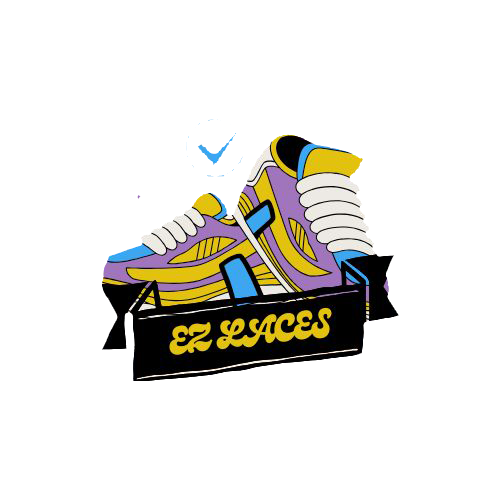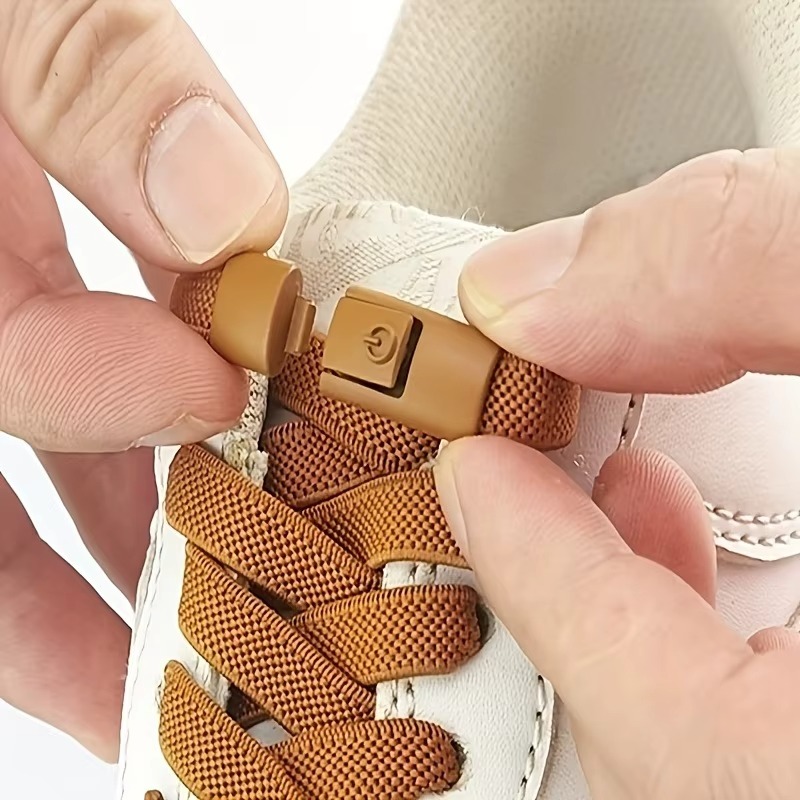Your cart is currently empty!
If you’ve ever been late because of a stubborn knot, tripped over a loose lace, or simply wished your sneakers could feel just right without constant fiddling, welcome to the tiny revolution that is no tie shoelaces. These simple elastic laces do one job — they replace tying with a secure, stretchable hold — and somehow they make daily life feel smoother. Below I’m going to deep-dive into the top 10 benefits of no tie shoelaces and explain why they’re such a quiet but powerful upgrade for runners, parents, gig workers, seniors, sneakerheads, and anyone who puts shoes on their feet.
This is long, thorough, and practical — consider it your one-stop resource for understanding how something as small as a lace can meaningfully improve everyday comfort.
Benefit 1 — Save Time: Faster Mornings, Fewer Hassles
Time is the most obvious win. No tie shoelaces remove the single most tedious part of putting on shoes: tying and re-tying.
- Instant on/off: Slip your foot in, slide the heel down, and you’re ready. No bowed loops, no double knots.
- Consistent fit every time: Elastic laces hold the same tension day after day, which means less micro-adjusting.
- Parent-saver: For parents wrangling kids to school, the minutes saved every morning add up into actual sanity.
Practical tip: Keep a pair of shoes with no tie shoelaces near the door for the fastest exits.
Benefit 2 — Better, More Consistent Fit
Traditional laces loosen with movement. Elastic, no tie shoelaces stretch and return, maintaining an even pressure across your foot.
- Even pressure distribution prevents hot spots and reduces friction that causes blisters.
- Adaptive fit — laces expand slightly when your foot swells during the day (or after a run), keeping comfort consistent.
- Improved lockdown for performance shoes — runners and gym-goers love that they don’t have to re-tie mid-activity.
Real-world result: Fewer blisters, fewer mid-activity shoe adjustments, and less annoyance.
Benefit 3 — Comfort for People with Mobility or Dexterity Challenges
One of the quietest, most meaningful benefits of no tie shoelaces is accessibility.
- Seniors or arthritis sufferers: tying laces can be painful or impossible; elastic laces drastically reduce that friction point.
- Children with fine motor skill delays: independence rises when kids can put on and take off shoes without help.
- Occupational ease: healthcare workers, retail staff, or anyone who changes shoes frequently benefit from the simplicity and speed.
Important note: Elastic laces don’t medicalize anything, but they do remove a routine barrier. For people with mobility concerns, they can be genuinely empowering.
Benefit 4 — Improved Safety — No Tripping, No Loose Ends
Loose laces are a surprisingly common cause of trips and workplace hazards.
- No dangling loops that can catch on pedals or stairs.
- Stable fit reduces foot slip inside the shoe, preventing slips and sprains.
- Good for kids and active workers — when little feet or fast feet are involved, you don’t want anything loose.
If you work around machinery or tools, swapping to no tie shoelaces is a small safety move with a big payoff.
Benefit 5 — Better Shoe Longevity and Performance
Elastic laces can reduce stress on eyelets and reduce repeated bending of lace material — preserving both laces and shoes.
- Even tension = less concentrated wear on eyelets and lace holes.
- Durability: quality elastic laces like EZ Laces resist fraying much longer than cheap cotton laces.
- Performance consistency: your shoe responds the same way every run, workout, or shift.
Sneaker collectors: elastic laces can preserve your shoes’ shape and reduce the need for aggressive tightening that can warp leather or uppers.
Benefit 6 — Style & Versatility — Look Good, Feel Good
No tie shoelaces aren’t just functional — they’re stylistic.
- Clean, minimalist aesthetic: perfect for sneakers, casual shoes, or even some dress shoes.
- Color and hardware variety: choose contrast colors or low-profile hardware for different looks.
- Layer with fashion choices: they pair well with cuffed pants, shorts, and activewear; the absence of dangling bows looks tidier.
Pro tip: swap lace color to refresh a sneaker’s vibe instantly — it’s a tiny mod with a huge visual impact.
Benefit 7 — Travel-Friendly — Pass Through Security Easier
If you travel often, you’ll appreciate the efficiency of no tie shoelaces.
- Faster TSA/security lines: slip on and off without re-tying.
- No worries about lost shoe hardware or laces while packing.
- Consistent fit after long flights: feet swell on planes; elastic laces adapt so you’re not uncomfortable on arrival.
Travel hack: wear shoes with elastic laces on flights to get through security and stay comfy during the trip.
Benefit 8 — Great for Sports & High-Activity Use
Athletes and fitness enthusiasts use elastic laces for a reason.
- Secure lockdown without pressure points: ideal for running, weightlifting, and court sports.
- Reduced re-ties during play: concentrate on performance, not your shoelaces.
- Quick adjustments between sessions: you can fine-tune tension pre-activity and trust it to hold.
Coach-approved? Many running groups and trainers recommend elastic laces for recreational athletes who want reliable fit without fuss.
Benefit 9 — Cost-Effective Over Time
Quality no tie shoelaces are a small purchase with a long shelf life.
- Spend once, benefit daily: fewer replacement laces, fewer visits to fix shoe eyelets.
- Reduced shoe replacement frequency: better fit and less wear means your shoes last longer.
- Free replacement policies: some brands (like EZ Laces) include long guarantees that make them an even smarter buy.
Small investment, steady returns: your morning routine costs less in both time and money.
Benefit 10 — Psychological Comfort — Less Friction in Your Day
This one is subtle but true: small conveniences compound.
- Reduced friction = reduced stress: fewer small annoyances add up to a cleaner mental space.
- Boosted independence: kids and people with differing abilities gain confidence when they can manage footwear themselves.
- Smoother habits: once a routine becomes frictionless, it stays that way — leading to more positive, consistent behavior.
The humble lace becomes a micro-optimisation of daily life.
How to Install No Tie Shoelaces (Quick Guide)
- Remove old laces. Clean eyelets if dusty.
- Thread EZ Laces like normal laces. Use a criss-cross pattern—most elastic laces replace each traditional lace hole.
- Adjust tension. Slide the shoe on, then tighten until snug but comfortable.
- Secure the locking mechanism. Many no tie solutions use a toggle or clip. Tuck excess lace under the tongue or use a small elastic keeper.
- Test with movement. Walk, jog in place, squat—make sure pressure feels even.
Common mistake: overtightening. Elastic is forgiving — let it do the work.
Maintenance & Care Tips
- Machine wash? Most quality elastic laces are machine-safe inside a mesh bag; check the manufacturer instructions.
- Air dry only. Heat can degrade elastic over time.
- Inspect periodically. Check the end crimps and toggles for wear. Replace if you notice fraying or loss of elasticity.
- Storage: keep spare laces in a labeled bag — colors fade in sunlight over months.
Common Questions (FAQ)
Q: Are no tie shoelaces safe during sports?
A: Yes — when properly installed they provide secure, even tension and reduce the need for mid-activity adjustments. For some elite athletes who need micro-adjustment, a hybrid approach may be preferred, but for most recreational sports, they’re excellent.
Q: Will my shoes fit differently after switching?
A: Slightly. Elastic laces create a consistent, snug fit rather than the variable tightness of tied laces. Most people find this improves comfort.
Q: Can I use them with dress shoes?
A: Many low-profile elastic laces work with minimal dress shoes, but leather dress shoes with thin eyelets may require discrete, low-bulk laces.
Q: How long do they last?
A: Quality elastic laces can last years under normal use; lifespan varies by activity level and exposure to elements.
Quick Comparison: No Tie Shoelaces vs Traditional Laces
- Speed: No tie laces win.
- Adjustability: Traditional laces allow fine-grain retightening; elastic laces provide consistent, adaptive tension.
- Aesthetic: Subjective — no tie laces are cleaner; tied laces are classic.
- Durability: Quality elastic laces last longer against repetitive tying/untie wear.
- Accessibility: No tie laces are more accessible for people with dexterity challenges.
Real-World Use Cases
- Busy parents save minutes every morning getting kids shoes on and out the door.
- Runners avoid stops on long runs to re-tie or adjust.
- Seniors and people with mobility limitations regain independence.
- Travelers and gig workers speed through security and shift changes.
- Sneaker enthusiasts maintain cleaner silhouettes and customized color pops.
Final Thoughts — Small Change, Big Comfort
Swapping to no tie shoelaces is one of those minor hacks that pays dividends daily. It’s not flashy. It doesn’t require a subscription. But it streamlines movement, improves safety, helps people regain independence, and — frankly — makes life feel just a little bit smarter and kinder.
If you’re on the fence, try them on one pair of frequently used shoes: your commuter sneakers, your kid’s school shoes, or your favorite running pair. Wear them for a week. If nothing else, you’ll learn how much tiny frictions shape your day—and how easily they can be smoothed out.


Leave a Reply